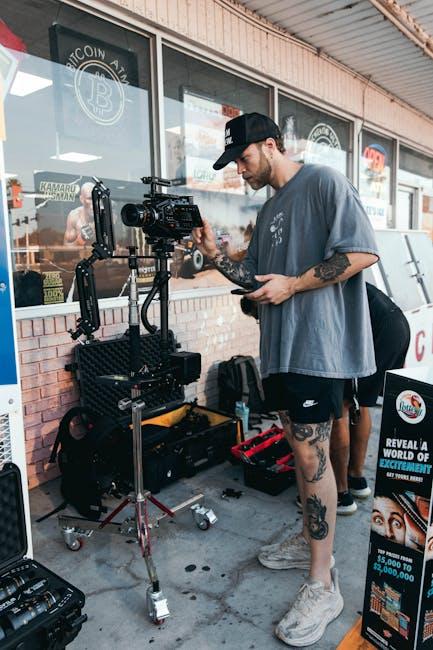In the ever-evolving world of cinema, a fresh wave of talent is rising, poised to reshape the industry’s landscape. These new directors, armed with bold visions and innovative storytelling techniques, are challenging conventions and breathing new life into the art form. As they carve their unique paths through uncharted creative territories, they not only reflect the changing dynamics of a global audience but also redefine what it means to be a filmmaker in the modern era. This article explores the journeys and influences of these emerging directors who are quietly, yet powerfully, transforming the face of the industry.
Table of Contents
- Innovative Storytelling Techniques Shaping Modern Cinema
- Diverse Voices Transforming Industry Norms
- Navigating Challenges in a Rapidly Evolving Market
- The Impact of Technology on Directorial Vision
- Fostering Inclusive Collaborations for Creative Growth
- Strategic Approaches for Emerging Directors to Gain Recognition
- Q&A
- Key Takeaways

Innovative Storytelling Techniques Shaping Modern Cinema
Today’s filmmakers are pushing the envelope, blending traditional narrative structures with groundbreaking visual and auditory methods that challenge audiences’ perceptions. Among these techniques are non-linear storytelling, immersive virtual reality experiences, and the use of real-time CGI to weave complex emotional landscapes. By merging technology with raw human emotion, these directors craft cinematic journeys that feel both intimate and expansive, allowing viewers to connect with stories on an unprecedented level.
Emerging directors are also experimenting with multisensory engagement, where sound design, lighting, and even tactile elements play pivotal roles in storytelling. This approach transforms movies from passive viewing into active experiences. Below is a snapshot of key innovative methods and their potential impact on modern cinema:
| Technique | Impact | Example Usage |
|---|---|---|
| Interactive Narratives | Audience chooses plot paths | Branching storylines in VR films |
| Dynamic Soundscapes | Heightened emotional immersion | 3D spatial audio in thrillers |
| Augmented Reality Layers | Enhanced story depth | Overlaying virtual elements in live scenes |
- Deconstructed timelines that mirror the complexity of memory
- Multi-perspective shots that reveal contrasting emotions simultaneously
- Hybrid documentary-fiction formats blending fact and imagination seamlessly

Diverse Voices Transforming Industry Norms
Emerging filmmakers from varied backgrounds are shattering traditional molds, bringing fresh perspectives and innovative storytelling methods to the forefront. Their inclusive narratives challenge longstanding industry conventions, ensuring that a broader range of experiences and cultures are authentically represented. This shift not only enriches the creative landscape but also fosters a more empathetic connection with audiences worldwide, highlighting stories that were once overlooked.
These visionary directors are redefining success metrics by prioritizing originality and depth over formulaic plots. Their work often embraces bold experimentation with genre, character development, and visual style, paving the way for a more dynamic and adaptive film industry. Below is a snapshot of key traits that characterize these trailblazing artists:
- Innovative narratives that break traditional structure
- Authentic representation of diverse communities
- Collaborative production methods emphasizing inclusivity
- Use of technology to amplify creative expression
| Director Profile | Notable Contribution | Impact |
|---|---|---|
| Global Storyteller | Bringing underrepresented cultures to the screen | Expanded audience engagement |
| Tech Innovator | Integrating VR and AR in narrative cinema | Revolutionized immersive experiences |
| Genre Bender | Blending documentary with fiction | Redefined storytelling boundaries |

Navigating Challenges in a Rapidly Evolving Market
In today’s dynamic landscape, directors must demonstrate agility and foresight to steer their companies through unpredictable waters. It’s no longer enough to rely on traditional strategies; successful leaders embrace innovation while managing risks effectively. They prioritize fostering a culture that values adaptability, encouraging teams to pivot quickly without losing sight of long-term objectives. Key attributes of these visionary directors include:
- Embracing emerging technologies early
- Promoting cross-functional collaboration
- Staying closely attuned to market shifts and consumer behavior
Moreover, rapid changes often demand new frameworks for decision-making and resource allocation. Directors equipped with data-driven insights can identify growth opportunities more efficiently, balancing experimentation with disciplined execution. The following table outlines how these leaders approach challenges versus traditional methods:
| Aspect | Traditional Approach | New Director Mindset |
|---|---|---|
| Risk Management | Avoid risks whenever possible | Calculated risk-taking to innovate |
| Customer Engagement | Static messaging and broad targeting | Personalized, data-informed campaigns |
| Decision Making | Top-down and hierarchical | Collaborative and agile |

The Impact of Technology on Directorial Vision
Emerging filmmakers are harnessing cutting-edge technology to reshape how stories come to life on screen. With tools like advanced CGI, virtual reality, and drone cinematography, directors now have an unprecedented arsenal to visualize their narratives with precision and innovation. This digital evolution expands the palette of creative expression, empowering directors to immerse audiences in worlds never before possible. Remote collaboration platforms and AI-driven editing software also streamline production workflows, granting directors more freedom to focus on artistic choices rather than logistical hurdles.
The integration of technology fosters new storytelling techniques, blending traditional cinematic elements with interactive and multimedia experiences. Some pioneering directors employ interactive VR scenes, allowing viewers to influence the storyline, while others utilize real-time rendering engines to experiment with lighting and camera angles dynamically. Below is a glimpse into how technology influences different directorial aspects:
| Directorial Aspect | Technological Influence |
|---|---|
| Visual Effects | Enhanced realism & creative fantasy worlds |
| Storytelling | Immersive & interactive narrative structures |
| Production | Remote collaboration & AI-assisted editing |
| Audience Engagement | Multi-platform viewing & VR/AR experiences |
These advancements encourage directors to push boundaries, combining artistry and innovation to captivate viewers in fresh, dynamic ways. As technology evolves, so too does the directorial vision, giving rise to a new generation of storytellers redefining cinematic language.

Fostering Inclusive Collaborations for Creative Growth
Embracing a spectrum of perspectives, new directors are transforming the creative landscape by championing collaboration that balances diverse voices with shared vision. These innovators understand that weaving varied cultural backgrounds, experiences, and storytelling styles results in richer narratives and groundbreaking cinematic techniques. By inviting voices traditionally underrepresented, they create environments where creativity flourishes through trust and empathy, rather than competition. The result is a tapestry of ideas that challenge industry norms and introduce fresh, compelling stories to audiences worldwide.
To cultivate such fertile creative spaces, these directors often employ practices that promote openness and adaptive learning. Key elements include:
- Cross-disciplinary teamwork: Integrating talents from writers, designers, and technologists to broaden creative possibilities.
- Regular feedback cycles: Encouraging transparent, constructive dialogues that refine ideas collaboratively.
- Inclusive leadership styles: Empowering all team members to contribute equally, irrespective of background.
| Collaboration Trait | Creative Impact |
|---|---|
| Respect for Diversity | Enables authentic storytelling |
| Adaptive Communication | Facilitates seamless idea exchange |
| Shared Decision-Making | Builds team ownership and innovation |

Strategic Approaches for Emerging Directors to Gain Recognition
Emerging directors often face a labyrinth of challenges, but adopting innovative and targeted methods can catapult their visibility. Building a robust network within the industry is indispensable; engaging with seasoned professionals and attending niche festivals allows new directors to showcase their unique voices. Leveraging digital platforms to share teasers, behind-the-scenes glimpses, and interactive Q&A sessions fosters a loyal, engaged audience beyond traditional venues. Additionally, collaborating with indie artists and writers can spark original projects that stand out, transforming passion into tangible recognition.
Understanding the power of storytelling extends beyond the screen—knowing how to pitch ideas and negotiate contracts with confidence can set burgeoning directors apart. Highlighted below is a simple yet effective strategy matrix for emerging directors to align their goals with actionable steps:
| Objective | Action Step | Expected Outcome |
|---|---|---|
| Expand Professional Network | Attend industry panels & virtual meet-ups | New collaborative opportunities |
| Enhance Digital Presence | Share regular content on social media | Grow engaged audience base |
| Refine Pitching Skills | Join workshops & practice elevator pitches | Increased project funding |
Q&A
Q&A:
Q: Who are these new directors making waves in the industry?
A: They are a diverse group of emerging filmmakers from around the globe, bringing fresh narratives, innovative techniques, and unique perspectives to cinema. Often younger and digitally savvy, they challenge traditional norms and inject renewed energy into the craft.
Q: What sets these new directors apart from the veterans?
A: While seasoned directors may rely on time-tested methods, new directors often experiment with storytelling, blending genres, and integrating cutting-edge technology. Their backgrounds and experiences reflect a broader spectrum of cultures and identities, leading to stories that resonate with a wider audience.
Q: How are these changes shaping the film industry?
A: The shifts are multifaceted: from the themes explored on screen—more inclusive, socially aware, and unconventional—to the business side with alternative funding models and distribution channels. These directors are expanding the industry’s creative and economic landscape.
Q: Can you give examples of influential new directors?
A: Filmmakers like Chloe Zhao, whose intimate storytelling and naturalistic style have redefined indie and mainstream cinema, or Barry Jenkins, known for poetic narratives that delve deep into identity and social issues, exemplify this new wave. Their successes highlight the industry’s evolving tastes.
Q: Are studios embracing this new wave of directors?
A: Gradually, yes. While initial hesitation existed due to market risks, the undeniable commercial and critical success of these directors is prompting studios to invest more confidently in fresh voices. Independent platforms and streaming services are especially supportive of such talents.
Q: What challenges do these new directors face?
A: Despite progress, barriers remain—such as funding difficulties, industry gatekeeping, and sometimes lack of experience navigating large-scale productions. Balancing originality with commercial viability also poses a constant challenge.
Q: How might the industry look in the next decade with these new directors at the helm?
A: We can anticipate a richer tapestry of stories that better reflect global realities and human experiences, accompanied by innovative filmmaking styles and technologies. The industry is likely to become more inclusive, adaptive, and audience-oriented, blurring the lines between genres and mediums.
Q: What can audiences do to support these new voices?
A: Audiences can seek out films by emerging directors, share and discuss their work, attend festivals, and support platforms that prioritize fresh talent. Active engagement helps these voices gain visibility and impact the broader cultural conversation.
Key Takeaways
As the curtain falls on this exploration of new directors reshaping the industry, it’s clear that fresh perspectives are not just a fleeting trend but a dynamic force driving evolution. These visionary storytellers challenge conventions, blend genres, and amplify diverse voices, reminding us that change is the lifeblood of creativity. While the future remains unwritten, one thing is certain: with new directors at the helm, the industry’s next act promises to be as compelling and transformative as ever.

